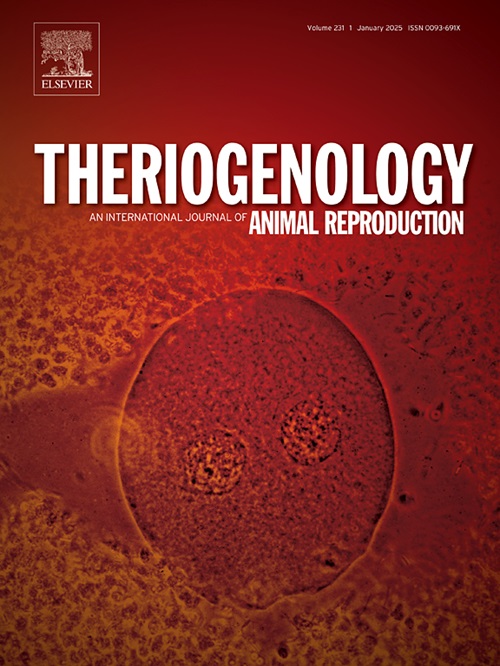子宫疾病对产后奶牛卵母细胞发育能力的短期和长期影响
IF 2.4
2区 农林科学
Q3 REPRODUCTIVE BIOLOGY
引用次数: 0
摘要
假设产后早期子宫疾病会降低卵母细胞的发育能力,从而导致患有子宫疾病的奶牛的生育能力下降。产后7-10 d诊断奶牛健康或子宫炎。在产后约1个月(实验1)或约80或165天(实验2)采集生殖道,收集卵母细胞卵母细胞复合物(COC)。COC成熟后与精子共孵育,体外培养至囊胚期(8 d)。对于Exp.1,疾病诊断(健康或子宫炎)不影响收集的COC数量或随后的胚胎发育到囊胚期。然而,在收集卵母细胞时,子宫腔内脓性物质(子宫内膜炎)的存在与受精后3天评估的卵裂率降低有关。对于实验2,疾病诊断(健康或度量炎)对COC数量或其后续发展没有影响。从产后80天屠宰的奶牛中提取的COC中观察到卵裂率降低,但在产后165天没有,这种减少与产后4-5周子宫疾病的阴道微生物组有关。包括血浆触珠蛋白或能量代谢物浓度或子宫细菌属丰度在内的回归分析并不能解释体外卵母细胞发育变化的很大比例。我们得出结论,产后1个月子宫疾病对卵母细胞及其发育能力有影响(实验1),这种影响可能在产后80天(实验2)存在。实验2)子宫疾病对体外卵母细胞发育无影响。本文章由计算机程序翻译,如有差异,请以英文原文为准。

Short- and long-term effects of uterine disease on oocyte developmental capacity in postpartum dairy cows
The hypothesis was that early postpartum uterine disease would reduce the developmental capacity of oocytes thus contributing to the reduced fertility of dairy cows with uterine disease. Dairy cows were diagnosed healthy or with metritis at 7–10 d postpartum. The reproductive tract was collected at approximately 1 mo (Exp. 1) or approximately 80 or 165 d (Exp. 2) postpartum for the collection of cumulus-oocyte complexes (COC). The COC were matured, co-incubated with sperm for fertilization, and cultured to the blastocyst stage (8 d) in vitro. For Exp.1, the disease diagnosis (healthy or metritis) did not affect the number of collected COC or the subsequent embryo development to the blastocyst stage. The presence of purulent material in the uterine lumen (endometritis) at time of oocyte collection, however, was associated with a reduced cleavage rate evaluated 3 d following fertilization. For Exp. 2, there was no effect of disease diagnosis (healthy or metritis) on the number of COC or their subsequent development. Reduced cleavage rates were observed in COC retrieved from cows slaughtered at 80 d postpartum, but not at 165 d postpartum, and this reduction was associated with a vaginal microbiome indicative of uterine disease at 4–5 wk postpartum. Regression analyses that included plasma haptoglobin or energy metabolite concentrations or uterine bacterial genera abundance did not explain a large percentage of the variation in oocyte development in vitro. We conclude that there is an effect of uterine disease at one month postpartum on the oocyte and its capacity for development (Exp. 1) and this effect may be present at 80 d postpartum (Exp. 2). In later postpartum cows (165 d postpartum; Exp. 2) there was no effect of uterine disease on in vitro oocyte development.
求助全文
通过发布文献求助,成功后即可免费获取论文全文。
去求助
来源期刊

Theriogenology
农林科学-生殖生物学
CiteScore
5.50
自引率
14.30%
发文量
387
审稿时长
72 days
期刊介绍:
Theriogenology provides an international forum for researchers, clinicians, and industry professionals in animal reproductive biology. This acclaimed journal publishes articles on a wide range of topics in reproductive and developmental biology, of domestic mammal, avian, and aquatic species as well as wild species which are the object of veterinary care in research or conservation programs.
 求助内容:
求助内容: 应助结果提醒方式:
应助结果提醒方式:


